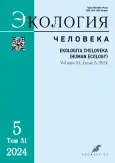Общий и интегральный анализ кардиоэффектов на острую гипоксию до и после интервальных гипоксических тренировок у человека на Севере России
- Авторы: Бочаров М.И.1, Шилов А.С.1
-
Учреждения:
- Коми научный центр Уральского отделения Российской академии наук
- Выпуск: Том 31, № 5 (2024)
- Страницы: 393-402
- Раздел: ОРИГИНАЛЬНЫЕ ИССЛЕДОВАНИЯ
- URL: https://journal-vniispk.ru/1728-0869/article/view/316571
- DOI: https://doi.org/10.17816/humeco630381
- ID: 316571
Цитировать
Полный текст
Аннотация
Обоснование. Одна из частных и мало изученных проблем экологической физиологии и медицины человека на Севере заключается в изучении функционирования сердца при развивающейся гипоксемии в холодный период года. Это и послужило предметом исследования.
Цель. Изучить характер изменений биоэлектрических процессов сердца, интегральную типологию реакций на острую гипоксию до и после интервальных нормобарических гипоксических тренировок у здорового человека в зимний период года на Севере России.
Материалы и методы. В исследование включены 29 мужчин (средний возраст 20,2±0,31 года), которых подвергали острой гипоксии (12,3% О2) в течение 20 мин с регистрацией оксигенации крови (SрO2%), трёх амплитудных и временны́х параметров ЭКГ в контроле и в период 1, 7 и 16 дней после курса интервальных нормобарических гипоксических тренировок. Определяли интегральные значения хроноинотропных эффектов сердца.
Результаты. В контроле при острой гипоксии прирастали P1II (р=0,005) и P-Q (р=0,006), уменьшались RII, T1II, R-R и Q-T (р <0,001). По сравнению с контролем после интервальных нормобарических гипоксических тренировок при острой гипоксии отклонение T1II уменьшается с 1-го (р=0,030) по 16-ый день (р <0,001), а P1II (р=0,020) — на 16-й день. Всегда отклонения T1II и Q-T коррелируют с таковым SрO2%. Во всех случаях с острой гипоксией частота эпизодов мезореактивных ответов составляет 42,5–47,1%, гиперреактивных — 24,1–29,9%, гипореактивных — 27,6–28,7%. Интегральные значения полярных хроноинотропных реакций на острую гипоксию с 7-го дня после интервальных нормобарических гипоксических тренировок увеличиваются по сравнению с контрольными значениями.
Заключение. Гипоксическая тренировка нивелирует изменения биоэлектрической активности правого предсердия при острой гипоксии и ослабляет торможение активности желудочков миокарда в фазе быстрой конечной реполяризации. Повышается зависимость систолы желудочков сердца от развивающейся гипоксемии. Количественные соотношения полярно отличающихся хроноинотропных эффектов не изменяются, но увеличиваются их интегральные средние значения.
Ключевые слова
Полный текст
Открыть статью на сайте журналаОб авторах
Михаил Иванович Бочаров
Коми научный центр Уральского отделения Российской академии наук
Автор, ответственный за переписку.
Email: bocha48@mail.ru
ORCID iD: 0000-0001-6918-5523
SPIN-код: 7435-1550
д-р биол. наук, профессор
Россия, СыктывкарАлександр Сергеевич Шилов
Коми научный центр Уральского отделения Российской академии наук
Email: shelove@list.ru
ORCID iD: 0000-0002-0520-581X
SPIN-код: 9039-4883
канд. биол. наук
Россия, СыктывкарСписок литературы
- Newsholme P., De Bittencourt P.I., O’Hagan C., et al. Exercise and possible molecular mechanisms of protection from vascular disease and diabetes: the central role of ROS and nitric oxide // Clin Sci (Lond). 2009. Vol. 118, N 5. P. 341–349. doi: 10.1042/CS20090433
- Semenza G.L. Hypoxia-inducible factors in physiology and medicine // Cell Physiol Biochem. 2012. Vol. 148, N 3. P. 399–408. doi: 10.1016/j.cell.2012.01.021
- Лукьянова Л.Д. Сигнальные механизмы гипоксии. Москва: РАН, 2019. EDN: ZXWRHB
- Агаджанян Н.А., Миррахимов М.М. Горы и резистентность организма. Москва: Наука, 1970.
- Физиология человека в условиях высокогорья / под ред. О.Г. Газенко. Москва: Наука, 1987.
- Казначеев В.П. Современные аспекты адаптации. Новосибирск: Наука, 1980. EDN: RZYABH
- Куликов В.Ю., Ким Л.Б. Кислородный режим при адаптации человека на Крайнем Севере. Новосибирск: Наука, 1987. EDN: SEWFPZ
- Пастухов Ю.Ф., Максимов А.Л., Хаскин В.В. Адаптация к холоду и условиям Субарктики: проблемы термофизиологии. Т. 1. Магадан: СВНЦ ДВО РАН, 2003. EDN: QKMKER
- Неверова Н.П., Барбашова З.И., Кононов А.С. Система дыхания. В кн.: Экологическая физиология человека. Адаптация человека к различным климатогеографическим условиям (руководство по физиологии). Ленинград: Наука, 1980. С. 109–121.
- Авцын А.П., Марачев А.Г. Проявление адаптации и дизадаптации у жителей Крайнего Севера // Физиология человека. 1975. Т. 1, № 4. С. 587–600.
- Якименко М.А., Нешумова Т.В., Ткаченко Е.Я. Потребление кислорода и некоторые показатели внешнего дыхания при адаптации к холоду // Физиология человека. 1977. Т. 3, № 4. С. 717–719. EDN: SMOPGT
- Литтл М.А., Ханна Дж.М. Реакции высокогорных популяций на воздействие холода и других стрессорных факторов. В кн.: Биология жителей высокогорья. Москва: Мир, 1981. С. 276–328.
- Sutton J.R., Houston C.S., Coates G., editors. Hypoxia and cold. N.-Y.: Westport, Connecticut London: Praeger, 1987.
- Le Blanc J. Metabolic responses to cold and hypoxia. In: Hypoxia and cold. N.-Y., Westport, Connecticut London: Praeger, 1987. P. 33–43.
- Волков Н.И. Прерывистая гипоксия — новый метод тренировки, реабилитации и терапии // Теория и практика физической культуры. 2000. № 7. С. 20–23.
- Navarrete-Opazo А., Mitchell G.S. Therapeutic potential of intermittent hypoxia: a matter of dose // Am J Physiol Regul Integr Comp Physiol. 2014. Vol. 307, N 10. P. R1181–R1197. doi: 10.1152/ajpregu.00208.2014
- Бочаров М.И., Шилов А.С. Анализ вариаций биоэлектрической активности сердца человека при острых гипоксических воздействиях // Экология человека. 2022. Т. 29, № 3. С. 33–43. EDN: WXBMRK doi: 10.17816/humeco71603
- Койчубеков Б.К., Сорокина М.А., Мхитарян К.Э. Определение размера выборки при планировании научного исследования // Международный журнал прикладных и фундаментальных исследований. 2014. № 4. С. 71–74. EDN: RZFUBV
- Малкин В.Б., Гиппенрейтер Е.Б. Острая и хроническая гипоксия. Москва: Наука, 1977.
- Аникина Т.А., Ситдиков Ф.Г. Пуринорецепторы сердца в онтогенезе. Казань: Типография ТГГПУ, 2011. EDN: QKTRMP
- Burnstock G. Purinergic signaling // Br J Pharmacol. 2006. Vol. 147, Suppl 1. P. S172–S187. doi: 10.1038/sj.bjp.0706429
- Новиков В.С., Сороко С.И., Шустов Е.Б. Дезадаптационные состояния человека при экстремальных воздействиях и их коррекция. Санкт-Петербург: Политехника-принт, 2018. EDN: XYPHID
Дополнительные файлы









